Tag: Corporate welfare
-
‘Earmark Distribution Agency,’ dealer of pork, proposed for elimination
Congressman Mike Pompeo, R-Kansas, offered an amendment to H.R. 4660, the Commerce, Justice, Science, and Related Agencies Appropriations Act for Fiscal Year 2015, to eliminate the Economic Development Administration (or the “Earmark Distribution Agency”).
-

Contrary to officials, Wichita has many incentive programs
Wichita government leaders complain that Wichita can’t compete in economic development with other cities and states because the budget for incentives is too small. But when making this argument, these officials don’t include all incentives that are available.
-

Poll: Wichitans don’t want sales tax increase
A scientific poll commissioned by Kansas Policy Institute finds that Wichitans are opposed to business incentives, want to pursue privatization over tax increases, and have concerns about how city hall has recently spent money.
-

Cronyism is welfare for rich and powerful, writes Charles G. Koch
The central belief and fatal conceit of the current administration is that you are incapable of running your own life, but those in power are capable of running it for you. This is the essence of big government and collectivism, writes Charles G. Koch.
-
Wichita not good for small business
When it comes to having good conditions to support small businesses, well, Wichita isn’t exactly at the top of the list, according to a new ranking from The Business Journals.
-
Wichita economic development: Worth higher taxes?
In this excerpt from WichitaLiberty.TV: Wichita city and business leaders are likely to ask Wichitans to support a higher sales tax in order to support additional economic development efforts. Should Wichitans vote in favor of this?
-
In Wichita, ‘free markets’ used to justify business welfare
Incredibly, a prominent Wichita business uses the free market to justify its request for economic development incentives. A gullible city council buys the argument.
-
Wichita City Council makes an uneconomic decision
The Wichita City Council was faced with a decision regarding a program designed to stimulate the sales of new homes. Analysis revealed that even though the city had an opportunity to make an investment with a purportedly high return on investment, it would be better off, dollar-wise, if it did not make the investment.
-
Your local chamber of commerce: Working for you?
Is your local chamber of commerce supporting pro-growth policies that allow free enterprise and genuine capitalism to flourish, or is it supporting crony capitalism?
-
Wichita City Council makes an economic decision
The Wichita City Council was faced with a decision regarding a program designed to stimulate the sales of new homes.. Analysis revealed that even though the city had an opportunity to make an investment with a purportedly high return on investment, it would be better off, dollar-wise, if it did not make the investment. What…
-
Change in needed in Wichita
Change is desperately needed in Wichita — change to allow exceptionalism and end failed economic subsidies.
-
Could Wichita be the next Detroit?
That Detroit has declared bankruptcy: Does this mean anything for Wichita?